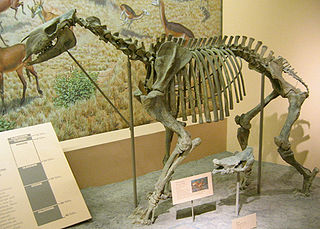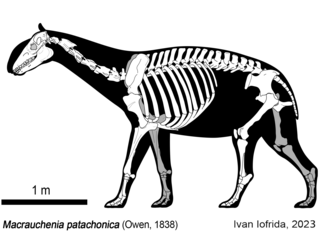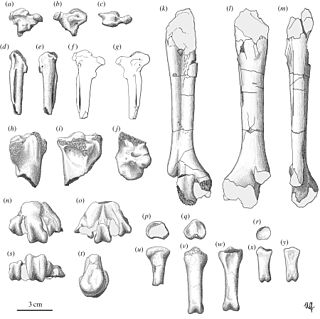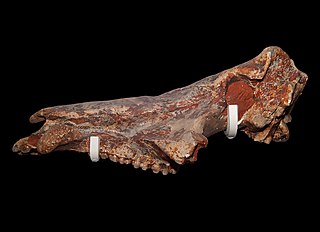
Ancylopoda is a group of browsing, herbivorous, mammals in the Perissodactyla that show long, curved and cleft claws. Morphological evidence indicates the Ancylopoda diverged from the tapirs, rhinoceroses and horses (Euperissodactyla) after the Brontotheria; however, earlier authorities such as Osborn sometimes considered the Ancylopoda to be outside Perissodactyla or, as was popular more recently, to be related to Brontotheriidae.

Viverridae is a family of small to medium-sized, feliform mammals. The viverrids comprise 33 species placed in 14 genera. This family was named and first described by John Edward Gray in 1821. Viverrids occur all over Africa, southern Europe, and South and Southeast Asia, across the Wallace Line.

Anseranatidae, the magpie-geese, is a biological family of waterbirds. The only living species, the magpie goose, is a resident breeder in northern Australia and in southern New Guinea.

Anas is a genus of dabbling ducks. It includes the pintails, most teals, and the mallard and its close relatives. It formerly included additional species but following the publication of a molecular phylogenetic study in 2009 the genus was split into four separate genera. The genus now contains 31 living species. The name Anas is the Latin for "duck".

Chalicotheriidae is an extinct family of herbivorous, odd-toed ungulate (perissodactyl) mammals that lived in North America, Eurasia, and Africa from the Middle Eocene to the Early Pleistocene. They are often called chalicotheres, a term which is also applied to the broader grouping of Chalicotherioidea. They are noted for their unusual morphology compared to other ungulates, such as their clawed forelimbs. Members of the subfamily Chalicotheriinae developed elongate gorilla-like forelimbs that are thought to have been used to grasp vegetation. They are thought to have been browsers on foliage as well as possibly bark and fruit.

Macraucheniidae is a family in the extinct South American ungulate order Litopterna, that resembled camelids. They had three functional digits on the fore and hind feet, as well as elongate necks. The family is generally divided up into two subfamilies, Cramaucheniinae and Macraucheniinae. The family shows retraction of the nasal region, most extremely to the top of the skull in derived macraucheniine taxa like Macrauchenia. which has been interpreted to have supported a probsocis, perhaps like that of a saiga antelope to filter dust, or a moose-like prehensile lip. The earliest unambiguous members of the family date to the late Oligocene around 30 million years ago. Polymorphis from the Eocene has historically been placed as a macraucheniid, but this has been doubted. Most early representatives had a body masses in the range of 80–120 kilograms (180–260 lb), though some like Llullataruca were as small as 35–55 kilograms (77–121 lb), and the last representatives of the family from the Pleistocene like Macrauchenia were over 1,000 kilograms (2,200 lb). The family reached its apex of diversity during the late Miocene around 10-6 million years ago, before declining to only a few species belong to the genera Macrauchenia and Xenorhinotherium by the Late Pleistocene.

Ancylotherium is an extinct genus of the family Chalicotheriidae, subfamily Schizotheriinae, endemic to Europe, Asia, and Africa during the Late Miocene-Early Pleistocene, existing for approximately 9.8 million years.

A genet is a member of the genus Genetta, which consists of 17 species of small African carnivorans. The common genet is the only genet present in Europe and occurs in the Iberian Peninsula, Italy and France.

Hemicyon, also known as the "dog-bear", is an extinct genus of hemicyonine bear, which probably originated in Eurasia but was found in Europe, Asia and North America during the Miocene epoch, existing for approximately 16 to 13 mya. Hemicyon is the best-known genus in the Hemicyoninae, a subfamily intermediate between bears and their Caniform ancestors but most often classified as bears. Hemicyonid bears should not be confused with Amphicyonids (bear-dogs), which are their own separate family of carnivores.

Lazarussuchus is an extinct genus of amphibious reptile, known from the Cenozoic of Europe. It is the youngest known member of Choristodera, an extinct order of aquatic reptiles that first appeared in the Middle Jurassic. Fossils have been found in Late Paleocene, Late Oligocene, Early Miocene and possibly Late Miocene deposits in France, Germany, and the Czech Republic. Two species have been named: the type species L. inexpectatus ("unexpected") from the late Oligocene of France. and L. dvoraki from the early Miocene of the Czech Republic. It was not a large animal; with the total preserved body and tail length of L. inexpectatus being just over 30 centimetres. A complete specimen of Lazarussuchus with preserved soft tissue was found from the Late Paleocene of France, but has not been assigned to a species.

Neosqualodon is an extinct genus of toothed cetacean, that lived in the Middle Miocene (Langhian) in what is now Italy. Their fossils - mostly teeth and jaws that are more robust and shorter than in the related genus Squalodon - have been recovered in the Ragusa Formation of Sicily. Two species are known: N. assenzae and N. gemellaroi, that are distinguished by the shape of the teeth. Apparently this genus was endemic to the pre-Mediterranean sea of the Late Oligocene.
Gerald Mayr is a German palaeontologist who is Curator of Ornithology at the Senckenberg Research Institute in Frankfurt am Main, Hesse. He has published extensively on fossil birds, especially the Paleogene avifauna of Europe. He is an expert on the Eocene fauna of the Messel pit.

Garganornis is an extinct genus of enormous flightless anatid waterfowl from the Late Miocene of Gargano, Italy. The genus contains one species, G. ballmanni, named by Meijer in 2014. Its enormous size is thought to have been an adaptation to living in exposed, open areas with no terrestrial predators, and as a deterrent to the indigenous aerial predators like the eagle Garganoaetus and the giant barn owl Tyto gigantea.

Microstonyx was an extinct genus of suid that existed during the Miocene in Asia and Europe.
Danuvius guggenmosi is an extinct species of great ape that lived 11.6 million years ago during the Middle–Late Miocene in southern Germany. It is the sole member of the genus Danuvius. The area at this time was probably a woodland with a seasonal climate. A male specimen was estimated to have weighed about 31 kg (68 lb), and two females 17 and 19 kg. Both genus and species were described in November 2019.
Madelaine Böhme is a German palaeontologist and professor of palaeoclimatology at the University of Tübingen.

Allgoviachen is an extinct genus of anatid bird from the Late Miocene (Tortonian) Hammerschmiede clay pits of Bavaria, Germany. The genus contains a single species, A. tortonica, known from bones belonging to the left leg.
Mesopotamocnus is an extinct genus of megalonychid ground sloth that lived during the Late Miocene in what is now Argentina. Fossils have been found in the Ituzaingó Formation of Argentina.

The Hammerschmiede clay pit is a fossil bearing locality in Pforzen, Bavaria, Germany most well known for the discovery of Danuvius guggenmosi, the potentially earliest known bipedal ape. With an age of 11.66-11.42 Ma the site dates to the transition between the Middle and Late Miocene epoch, providing an important window into the faunal changes taking place during this time. This correlates to the time just after the Serravallian-Tortonian boundary, and the MN zones 7/8. It is one of the most well-known Miocene sites, with over 15,000 individual fossils and 117 species having been discovered as of 2020. It has been called "the most important German paleontological discovery of the last decades".

Buronius is an extinct genus of hominid from the late Miocene Hammerschmiede clay pit of Bavaria, Germany. The genus contains a single species, B. manfredschmidi, known from two partial teeth and a patella. Buronius may represent the smallest known hominid. The more well-known great ape Danuvius is known from the same locality.















